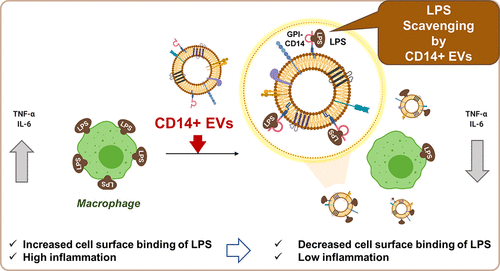当前位置:
X-MOL 学术
›
ACS Appl. Mater. Interfaces
›
论文详情
Our official English website, www.x-mol.net, welcomes your
feedback! (Note: you will need to create a separate account there.)
Glycolipid-Anchored Proteins on Bioengineered Extracellular Vesicles for Lipopolysaccharide Neutralization
ACS Applied Materials & Interfaces ( IF 8.3 ) Pub Date : 2021-06-17 , DOI: 10.1021/acsami.1c05108 Divakara Ssm Uppu 1 , Yoohong Min 1 , Inun Kim 1 , Sumit Kumar 1 , Juhee Park 1 , Yoon-Kyoung Cho 1, 2
ACS Applied Materials & Interfaces ( IF 8.3 ) Pub Date : 2021-06-17 , DOI: 10.1021/acsami.1c05108 Divakara Ssm Uppu 1 , Yoohong Min 1 , Inun Kim 1 , Sumit Kumar 1 , Juhee Park 1 , Yoon-Kyoung Cho 1, 2
Affiliation

|
Extracellular vesicles (EVs) with native membrane proteins possess a variety of functions. EVs have become increasingly important platforms for incorporating a new peptide/protein with additional functions on their membranes using genetic manipulation of producer cells. Although directly harnessing native membrane proteins on EVs for functional studies is promising, limited studies have been conducted to confirm its potential. This study reports bioengineered EVs with CD14, a natural glycosylphosphatidylinositol (GPI)-anchored protein and a selectively enriched native membrane protein on EVs. We demonstrated that producer cells transfected with genes encoding for GPI-anchored and transmembrane glycoproteins selectively display the former over the latter on bioengineered EVs. Furthermore, using specific enzyme cleavage studies, we characterized and validated that CD14 is indeed GPI-anchored on bioengineered EV membranes. Natural GPI-anchored proteins are conserved receptors for bacterial toxins; for example, CD14 is an innate immune receptor for lipopolysaccharide (LPS), a gram-negative bacterial endotoxin. We reported that unlike soluble CD14, bioengineered EVs harboring CD14 reduce (50–90%) LPS-induced cytokine responses in mouse macrophages, including primary cells, possibly by reduced cell surface binding of LPS. These findings highlight the importance of harnessing the native EV membrane proteins, like GPI-anchored proteins, for functional studies such as toxin neutralization. The GPI-anchoring platform can display various natural GPI-anchored proteins and other full-length proteins as GPI-anchored proteins on EV membranes.
中文翻译:

用于脂多糖中和的生物工程细胞外囊泡上的糖脂锚定蛋白
具有天然膜蛋白的细胞外囊泡 (EV) 具有多种功能。EVs 已成为越来越重要的平台,用于使用生产细胞的遗传操作在其膜上加入具有附加功能的新肽/蛋白质。尽管直接利用 EV 上的天然膜蛋白进行功能研究很有前景,但已经进行了有限的研究来证实其潜力。这项研究报告了带有 CD14 的生物工程 EV,CD14 是一种天然糖基磷脂酰肌醇 (GPI) 锚定蛋白和 EV 上选择性富集的天然膜蛋白。我们证明了用编码 GPI 锚定和跨膜糖蛋白的基因转染的生产细胞在生物工程 EV 上选择性地显示前者而不是后者。此外,使用特定的酶切研究,我们表征并验证了 CD14 确实是 GPI 锚定在生物工程 EV 膜上的。天然 GPI 锚定蛋白是细菌毒素的保守受体;例如,CD14 是脂多糖 (LPS)(一种革兰氏阴性细菌内毒素)的先天免疫受体。我们报告说,与可溶性 CD14 不同,含有 CD14 的生物工程 EV 减少(50-90%)小鼠巨噬细胞(包括原代细胞)中 LPS 诱导的细胞因子反应,这可能是由于 LPS 的细胞表面结合减少。这些发现强调了利用天然 EV 膜蛋白(如 GPI 锚定蛋白)进行毒素中和等功能研究的重要性。GPI 锚定平台可以在 EV 膜上显示各种天然 GPI 锚定蛋白和其他全长蛋白作为 GPI 锚定蛋白。
更新日期:2021-06-30
中文翻译:

用于脂多糖中和的生物工程细胞外囊泡上的糖脂锚定蛋白
具有天然膜蛋白的细胞外囊泡 (EV) 具有多种功能。EVs 已成为越来越重要的平台,用于使用生产细胞的遗传操作在其膜上加入具有附加功能的新肽/蛋白质。尽管直接利用 EV 上的天然膜蛋白进行功能研究很有前景,但已经进行了有限的研究来证实其潜力。这项研究报告了带有 CD14 的生物工程 EV,CD14 是一种天然糖基磷脂酰肌醇 (GPI) 锚定蛋白和 EV 上选择性富集的天然膜蛋白。我们证明了用编码 GPI 锚定和跨膜糖蛋白的基因转染的生产细胞在生物工程 EV 上选择性地显示前者而不是后者。此外,使用特定的酶切研究,我们表征并验证了 CD14 确实是 GPI 锚定在生物工程 EV 膜上的。天然 GPI 锚定蛋白是细菌毒素的保守受体;例如,CD14 是脂多糖 (LPS)(一种革兰氏阴性细菌内毒素)的先天免疫受体。我们报告说,与可溶性 CD14 不同,含有 CD14 的生物工程 EV 减少(50-90%)小鼠巨噬细胞(包括原代细胞)中 LPS 诱导的细胞因子反应,这可能是由于 LPS 的细胞表面结合减少。这些发现强调了利用天然 EV 膜蛋白(如 GPI 锚定蛋白)进行毒素中和等功能研究的重要性。GPI 锚定平台可以在 EV 膜上显示各种天然 GPI 锚定蛋白和其他全长蛋白作为 GPI 锚定蛋白。


















































 京公网安备 11010802027423号
京公网安备 11010802027423号